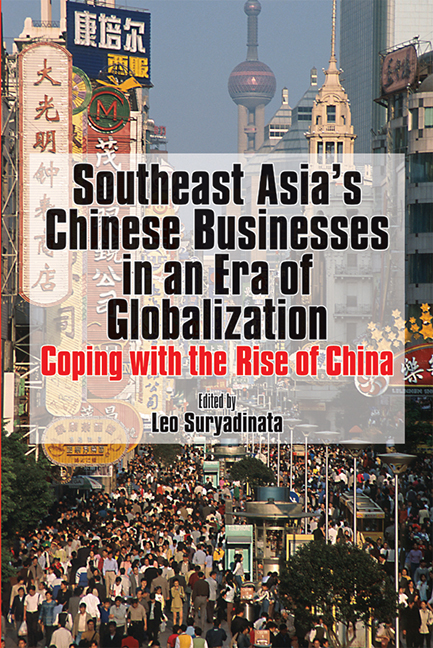Book contents
- Frontmatter
- Contents
- The Contributors
- Introduction
- China and Southeast Asia
- 1 China's Economic Rise and Its Implications for Southeast Asia: The Big Picture
- 2 The Emergence of China's Economic Power and Its Implications for Chinese Businesses in Southeast Asia
- Indonesia
- Malaysia
- The Philippines
- Singapore and Thailand
- Index
1 - China's Economic Rise and Its Implications for Southeast Asia: The Big Picture
from China and Southeast Asia
Published online by Cambridge University Press: 21 October 2015
- Frontmatter
- Contents
- The Contributors
- Introduction
- China and Southeast Asia
- 1 China's Economic Rise and Its Implications for Southeast Asia: The Big Picture
- 2 The Emergence of China's Economic Power and Its Implications for Chinese Businesses in Southeast Asia
- Indonesia
- Malaysia
- The Philippines
- Singapore and Thailand
- Index
Summary
CHINA IN REGIONAL PERSPECTIVE
Since 1979, China's economy has experienced spectacular growth as a result of its successful economic reform and open-door policy. In the process, China's economy has also become more closely integrated with its neighbouring economies in East Asia (EA). China's sustained dynamic economic growth has produced a profound impact on the EA region, including the Association of the Southeast Asian Nations (ASEAN).
Initially, the more developed Japan and the four East Asian NIEs (newly industrialized economies) of South Korea, Taiwan, Hong Kong and Singapore (which were economically complementary with China) captured most of the benefits of China's open-door policy by actively trading with and investing in China.
As China continued to press ahead with its export-oriented development strategies, it started to cast a large shadow on the less developed ASEAN economies to its south, many of which were competing head-on with China to attract foreign direct investment (FDI) and in exporting manufactured products to the same third-country markets. The rise of China was at one time considered to be a disruptive force to ASEAN's economic growth, which had lost quite a lot of its former dynamism after the 1997 Asian financial crisis. In recent years, however, as China's imports of ASEAN's manufactured products as well as its primary commodities and natural resources have sharply increased, China's economy has also operated as an additional source of economic growth for the ASEAN economies.
Furthermore, to allay ASEAN's growing apprehension of China, Beijing took a bold step to arrange an FTA (free trade agreement) with ASEAN in order to turn competition into complementation. Signed in November 2002, this landmark Sino-ASEAN FTA deal is designed to increase the region's trade and investment to the benefit of both sides. But it has also indirectly exerted a lot of pressures on Japan and Korea to follow suit by intensifying their economic relations with ASEAN under the general regional cooperation umbrella of the ASEAN plus China, Japan and Korea (ASEAN+3) scheme.
- Type
- Chapter
- Information
- Southeast Asia's Chinese Businesses in an Era of GlobalizationCoping with the Rise of China, pp. 13 - 37Publisher: ISEAS–Yusof Ishak InstitutePrint publication year: 2006



